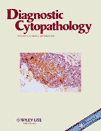Comparison of three different staining techniques for intraoperative assessment of nodal metastasis in breast cancer
Abstract
Imprint cytology has increasingly been used for intraoperative assessment of nodal status in breast cancer. We carried out this study to compare the efficacy of Jenner Giemsa (JG), hematoxylin-eosin (H&E), and Papanicolaou (Pap) stains for intraoperative lymph node imprint cytology (IIC) in breast cancer. One hundred and seven cases of stage I–III breast cancer were studied. Overall, IIC was accurate in 95.3% cases and had a sensitivity and specificity of 98.5% and 90.0%, respectively. The accuracy of JG (95.3%) was better than that of H&E (90.6%) and Pap (94.0%), although the differences were not statistically significant. Problems encountered included cell loss and drying artifacts with H&E and Pap and the inability to distinguish between tumor cells and histiocytes confidently in tight cellular clusters that were occasionally seen. Opinion was possible in all JG cases, but not in five and four cases by H&E and Pap, respectively. Although the choice of the stain would vary depending on the experience of the pathologist, our work suggests that JG, because of fewer technical problems and superior accuracy, may be preferable over H&E and Pap. Diagn. Cytopathol. 2004;31:423–426. © 2004 Wiley-Liss, Inc.




